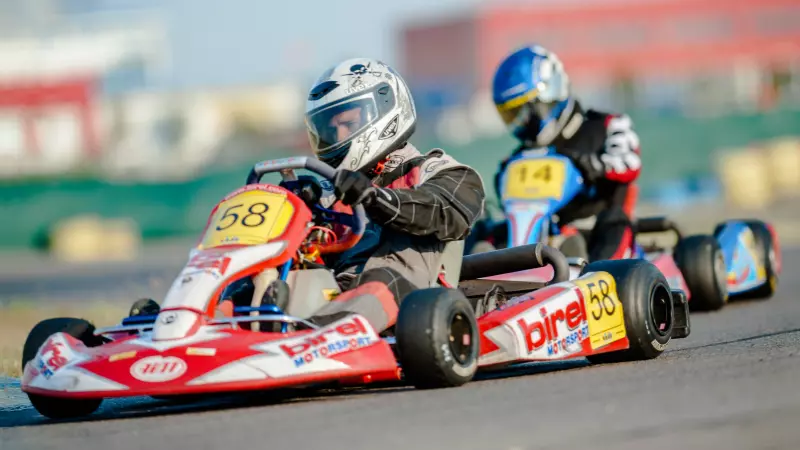A go-kart contains various components that help transfer power generated from the engine to the rear axle and ultimately the rear wheels. One of these components is a transmission, which is a mechanical device that is connected to the crankshaft.
In this article, we’ll take a detailed look at all of the go-kart transmission types, how they work and which scenarios they’re best suited for. I’ve also included an FAQ section towards the end of the article for further reference and information.
What Is a Go-Kart Transmission?
A transmission on a go-kart is a mechanical device that transfers the rotational force that is generated by the go-kart engine to the rear axle and ultimately the two rear wheels, enabling your go-kart to accelerate.
The three most common go-kart transmission types are direct drives (which have no transmission), automatic transmissions (torque converter and clutch) or manual transmissions (gear box). Here’s a quick summary of each transmission type:
- No Transmission: Direct Drive
- Automatic Transmission: Clutch and Torque Converter
- Manual Transmission: Gearbox
The type of transmission on a go-kart will mainly depend on the type of go-kart and how it’s operated. For example, go-kart torque converters are more commonly seen on homemade and off-road go-karts, whereas manual gearboxes and clutches are generally found on racing go-karts.
Below, you’ll see a quick comparison between the various types of go-kart transmissions. As you can see, each of these transmissions has different properties and is therefore also used for different applications and racing classes.

Clutch
Type: Automatic
System: Chain
Gear Ratio: Fixed
Efficiency: <100%
Torque: High-End
Cost: Low to High
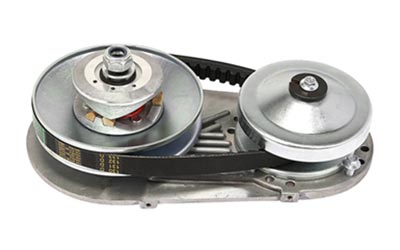
Torque Converter
Type: Automatic
System: Belt
Gear Ratio: Variable
Efficiency: 80%
Torque: Low-End
Cost: Low to Medium
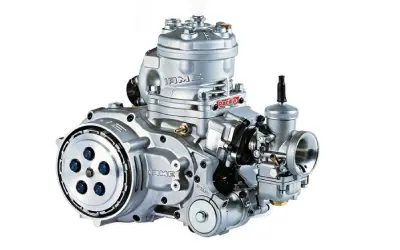
Gearbox
Type: Manual
System: Chain/Clutch
Gear Ratio: Selective
Efficiency: <100%
Torque: High-End
Cost: Very High
In the following section, we’ll go through each of these transmission types in more detail and also explore more technical information about them. This will help you understand why they are more common on certain types of go-karts.
No Transmission
Technically speaking, not having a go-kart transmission is not a type of transmission. However, it is a type of configuration that isn’t too uncommon for smaller, electric or homemade go-karts. Go-karts without a transmission are referred to as having a direct drive.
Automatic Transmissions
An automatic go-kart transmission such as a torque converter or a clutch has the ability to automatically engage and disengage when the crankshaft reaches a certain speed (revolutions per minute; abbreviated as RPM).
This also means that automatic transmissions allow go-karts to idle, when it is disengaged (when the RPM falls below a certain speed) and engage (when the RPM goes above a certain speed).
I’ve created a comprehensive guide that explores the similarities and differences between go-kart torque converters vs clutches. Feel free to find out more detailed information there.
Manual Transmissions
Manual transmissions on go-karts are gearboxes that allow drivers to engage a specific gear using a gear knob. This gives them free control over the section of a particular gear ratio when racing.
Shifter karts are typically equipped with a six-speed manual gearbox that is used for competitive racing in certain classes, which are more common in Europe and the United States.
Direct Drive
Karts that don’t have a transmission installed are called direct drive go-karts. This is because they transfer rotational force from the engine directly to the rear axle through a sprocket and a roller chain (without any transmission).
This also means that there is no way for gas-powered go-karts to variably adjust the power transfer to the rear wheels and is therefore constantly engaged.
Direct drive go-karts don’t have any idling capabilities, unless the engine itself does. This also means that the go-kart will start moving the moment the engine is turned on. While the go-kart’s speed can be controlled through the accelerator and brake pedal, the gear ratio is always constant and is not variable compared to a torque converter for example.
Electric go-karts with direct drive are more common as there is no need for a clutch or torque converter. Thanks to speed controllers, electric go-karts use a direct drive configuration.
However, it’s rare to see gas-powered go-karts using a direct drive configuration, as transmissions for recreational go-karts are affordable and useful.
For professional racers, a centrifugal racing clutch or a manual gearbox is required, especially when races are sanctioned by karting authorities such as the CIK-FIA. Here are some of the pros and cons of direct drive go-karts.
Pros
- Cheapest setup
- No additional mechanical parts
- Great for electric karts
Cons
- No idling
- Constant engagement
- No variable gear ratio
- Can wear out parts faster
Go-Kart Clutch
A go-kart clutch is a non-variable automatic transmission, meaning that it operates on a fixed gear ratio. A clutch is located on the crankshaft and transfers rotational force from the engine to the rear axle.

- Fully engages at around 1,800 RPM
- Friction material pushes outward
- Suitable for high speeds
- Uses a sprocket and roller chain
There are various types of clutches for go-karts. While they are differently designed and also engage through different mechanisms, they achieve the same thing, which is to transfer power to the rear axle. Here’s a list of the most common go-kart clutches.
- Centrifugal Clutches (most common)
- Belt Clutches
- Electric Clutches
- Hydraulic Clutches
Centrifugal clutches are the most common, as they are the least expensive and also one of the least complex transmissions. While there are single and multi-disk racing clutches, they work in a similar fashion.
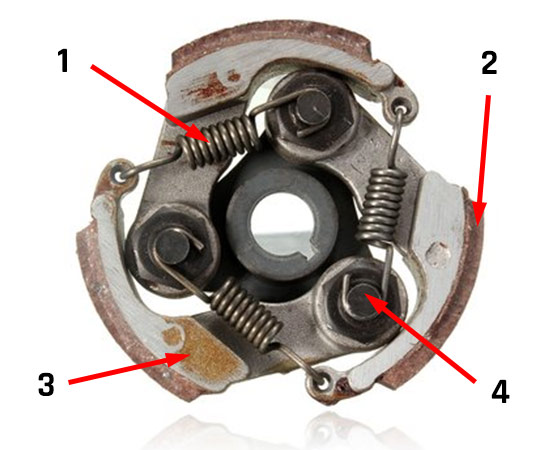
Go-Kart Clutch Description
- Tension Spring
- Friction Material
- Flyweight/Shoe
- Pivots
Here’s how a go-kart clutch works. When the engine’s crankshaft spins at about 1,400 to 1,600 RPM enough force is exerted onto the tension springs that they expand and the flywheels (also called shoes) move outward. This causes the friction material to make contact with the inner drum of the clutch.
Once the friction material makes full contact with the inner drum, the clutch is engaged and spins along with the crankshaft, which spins the rear axle via a chain. This happens at about 1,800 RPM, depending on the type of centrifugal clutch.
Operating a clutch at about 1,400 to 1,600 RPM (not fully engaged) may cause the clutch to slip and potentially wear faster. Therefore, go-kart clutches are commonly seen on racing go-karts that accelerate quickly and more consistently. Here are some of the pros and cons of go-kart clutches.
Pros
- Optimal for racing go-karts
- Inexpensive
- Engine can idle
- Easy to set up
Cons
- Can wear due to slipping
- No variable gear ratio
Go-Kart Torque Converter
Go-kart torque converters are variable transmissions, which means that they don’t have a fixed gear ratio. Torque converters typically start with a gear ratio that is about 2:1 and will move closer to a 1:1 ratio, the faster the crankshaft spins.

- Engages at about 1,500 RPM
- Consists of 2 pulleys
- Variable transmission
- Disengages while idling
While a go-kart torque converter also has an engagement range through a spring system, it typically engages much earlier at about 1,500 RPM. The variable gear ratio is ideal for go-karts under heavy load or when racing on inclined surfaces.
Therefore, torque converters are commonly found on homemade or off-road go-karts. Let’s take a closer look at the components of a torque converter, before I explain how they work.
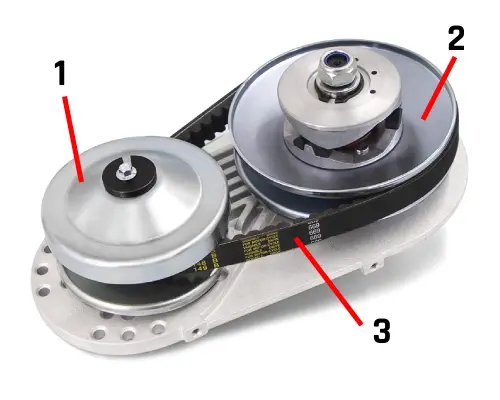
Go-Kart Torque Converter Description
- Driver Pulley
- Driven Pulley
- Belt
The driver pulley (also called driving pulley) is connected to the crankshaft of the go-kart engine. Once the crankshaft spins to a certain RPM, the pulley clamps onto the belt, causing the driven pulley to spin.
Both the driver and the driven pulleys are connected with a belt and as the belt moves up the driver pulley when the RPM is increased. When this happens, the gear ratio changes.
The driven pulley is connected to the rear axle via a sprocket and chain. This allows the torque converter to provide the rear axle with variable rotation force, which can decrease or increase depending on the engine speed.
Below about 1,500 RPM, torque converters are disengaged and don’t transfer power to the rear axle. One advantage that torque converters have over clutches is that they have considerably lower wear, especially under heavier loads. Here are some of the pros and cons of a go-kart torque converter.
Pros
- Optimal for off-road go-karts
- Inexpensive
- Engine can idle
- Less prone to wear
- Variable gear ratio
Cons
- Requires belt replacements
- Spring adjustments may be required
- Lower efficiency
Go-Kart Gearbox
Certain racing go-karts have a gearbox, which allows the driver to change gears whenever required. Similar to an automobile, gears are changed through a gear knob. However, one major difference is that the gearbox is typically built into the go-kart engine.

- Built into the engine
- Six-speed manual gearbox
- Various gear ratios
- Requires maintenance
Go-karts that are fitted with a gearbox are known to have a manual transmission, and these types of go-karts are called shifter karts. While certain kart classes (predominantly 125cc and above) in Europe use gearboxes, shifter karts are more common in the United States.
Shifter go-karts typically have a six-speed manual transmission and a racing clutch, whereby each gear will have a different gear ratio. This allows drivers to get the most out of their engine and have the ability to up or downshift when they need to decrease or increase the gear ratio.
Outside of professional go-karts, manual transmissions are relatively rare, apart from some homemade projects. This is because gearboxes can be very expensive, need to be regularly maintained and can be complex to install.
Pros
- Used for shifter karts
- Gets most out of the engine
- Multiple gear ratios
- Can manually change gears
Cons
- Expensive
- Heavy maintenance
- Complex installation
Frequently Asked Questions
As you’re able to tell, there are various types of go-kart transmission and each type is suitable for a specific application. I’ve compiled a list of answers to some of the most frequently asked questions on go-kart transmissions.
If you have questions that are not included in this list and would like to have them answered, please feel free to reach out to me and I will make sure to include them.
Are Transmissions Required on Go-Karts?
You’re not required to have a transmission on a go-kart for it to work. However, an automatic or manual transmission is recommended, as you’ll be able to idle and also more easily control the power transfer of the engine to the rear axle.
If you opt to proceed without a transmission, you’ll have a direct drive setup, whereby the crankshaft is connected to the rear axles directly through two sprockets and a chain.
Which Transmission Is Best For My Go-Kart
While all transmissions have the same purpose (transmitting rotational force from the engine to the rear axle) they achieve this through different methods that each have pros and cons.
Head to the section above to explore more about each type of transmission and what application they are best suited for. You may also use below for reference:
- Torque Converters: Off-road go-karts, heavy loads, low-speed go-karts
- Clutches: Racing go-karts, light loads, high-speed karts
- Gearbox: Shifter karts (professional or semi-professional racers)
If you’re looking to buy a transmission for your go-kart then feel free to read my in-depth reviews of the best go-kart clutches and the best go-kart torque converters. Each of these reviews comes with an extensive buying guide to address all of your questions.
Which Transmission Is Most Reliable for Go-Karts?
All go-karts components, automatic and manual transmissions included, contain moving parts, which go through regular wear and tear.
For example, it’s common for go-kart clutches to lock up due to excessive heat when slipping. Another common issue is that they can lose effectiveness if the springs have been worn out over time.
Torque converters belts make regular contact with both pulleys and can show excessive wear if not installed properly or if operated near the engagement range over a prolonged period of time.
Manual gearboxes are extremely complex to install and also maintain. Gear wheels may need to be replaced from time to time, as they are almost always under high load.
In essence, all go-kart transmissions need some form of maintenance and are only as reliable as your driving habits. Just ensure that whichever transmission you’ve installed, that you fully engage it.
How Do I Install a Transmission On a Go-Kart?
Both torque converters and clutches are installed on the crankshaft of the engine. However, it’s important to note that the setup between both transmissions is completely different – but don’t worry!
I’ve created a comprehensive guide on how to install a go-kart clutch and how to install a go-kart torque converter that you can use. Just make sure that you follow each step carefully and that you have the right tools with you.
How Do I Fix a Transmission On a Go-Kart?
As go-kart transmissions are subject to regular wear, they need to be maintained from time to time. With age, they may need to be fixed or repaired. Here’s a quick list of what may need to get fixed with a link to each guide that I have created.
Fix a Go-Kart Clutch
Fix a Go-Kart Torque Converter
